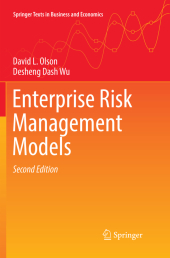 Neuerscheinungen 2018Stand: 2020-02-01 |
Schnellsuche
ISBN/Stichwort/Autor
|
Herderstraße 10
10625 Berlin
Tel.: 030 315 714 16
Fax 030 315 714 14
info@buchspektrum.de |

David L. Olson, Desheng Dash Wu
(Beteiligte)
Enterprise Risk Management Models
2. Aufl. 2018. ix, 216 S. 9 SW-Abb., 36 Farbabb., 35 Farbtabellen. 235 mm
Verlag/Jahr: SPRINGER, BERLIN; SPRINGER BERLIN HEIDELBERG 2018
ISBN: 3-662-57159-5 (3662571595)
Neue ISBN: 978-3-662-57159-0 (9783662571590)
Preis und Lieferzeit: Bitte klicken
Enterprise risk management has always been important. However, the events of the 21st Century have made it even more critical. The top level of business management became suspect after scandals at ENRON, WorldCom, and other business entities. Financially, many firms experienced difficulties from bubbles. The problems of interacting cultures demonstrated risk from terrorism as well, with numerous terrorist attacks, to include 9/11 in the U.S. Risks can arise in many facets of business. Businesses in fact exist to cope with risk in their area of specialization. Financial risk management has focused on banking, accounting, and finance. We have discussed several aspects of risk, to include information systems, disaster management, and supply chain perspectives. The bulk of this book is devoted to presenting a number of operations research models that have been (or could be) applied to enterprise supply risk management, especially from the supply chain perspective.
This book is a comprehensive guide to several aspects of risk, including information systems, disaster management, supply chain and disaster management perspectives. A major portion of this book is devoted to presenting a number of operations research models that have been (or could be) applied to enterprise supply risk management, especially from the supply chain perspective. Each chapter of this book can be used as a unique module on a different topics with dedicated examples, definitions and discussion notes.
This book comes at a time when the world is increasingly challenged by different forms of risk and how to manage them. Events of the 21st Century have made enterprise risk management even more critical. Risks such as suspicions surrounding top-management structures, financial and technology bubbles (especially since 2008), as well as the demonstrated risk from terrorism, such as the 9/11 attack in the U.S. as well as more recent events in France, Belgium, and other locations in Europe, have a tremendous impact on many facets of business. Businesses, in fact, exist to cope with risk in their area of specialization.
Enterprise Risk Management in Supply Chains.- Risk Matrices.- Value-Focused Supply Chain Risk Analysis.- Examples of Supply Chain Decisions Trading Off Criteria.- Simulation of Supply Chain Risk.- Value at Risk Models.- Chance Constrained Models.- Data Envelopment Analysis in Enterprise Risk Management.- Balanced Scorecards to Measure Enterprise Risk Performance.- Information Systems Security Risk.- Enterprise Risk Management in Projects.- Natural Disaster Risk Management.- Sustainability Risk Management.- Environmental Damage and Risk Assessment.


